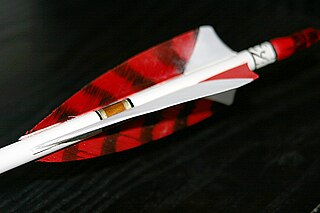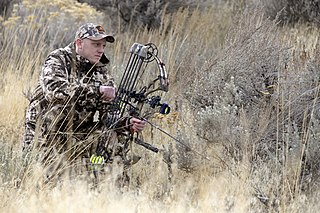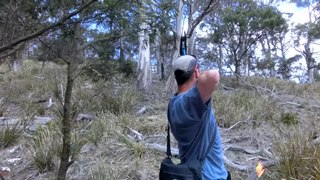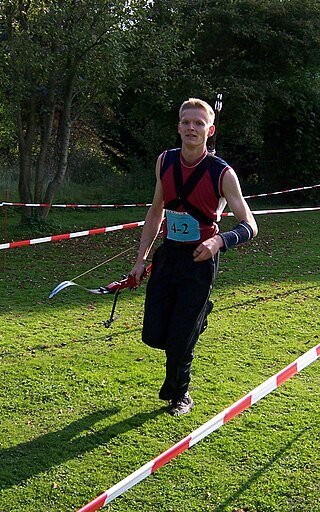
Archery is the sport, practice, or skill of using a bow to shoot arrows. The word comes from the Latin arcus, meaning bow. Historically, archery has been used for hunting and combat. In modern times, it is mainly a competitive sport and recreational activity. A person who practices archery is typically called an archer, bowman, or toxophilite.

An arrow is a fin-stabilized projectile launched by a bow. A typical arrow usually consists of a long, stiff, straight shaft with a weighty arrowhead attached to the front end, multiple fin-like stabilizers called fletchings mounted near the rear, and a slot at the rear end called a nock for engaging the bowstring. A container or bag carrying additional arrows for convenient reloading is called a quiver.

In modern archery, a compound bow is a bow that uses a levering system, usually of cables and pulleys, to bend the limbs. The compound bow was first developed in 1966 by Holless Wilbur Allen in North Kansas City, Missouri, and a US patent was granted in 1969. Compound bows are widely used in target practice and hunting.

The bow and arrow is a ranged weapon system consisting of an elastic launching device (bow) and long-shafted projectiles (arrows). Humans used bows and arrows for hunting and aggression long before recorded history, and the practice was common to many prehistoric cultures. They were important weapons of war from ancient history until the early modern period, where they were rendered increasingly obsolete by the development of the more powerful and accurate firearms. Today, bows and arrows are mostly used for hunting and sports.

Fletching is the fin-shaped aerodynamic stabilization device attached on arrows, bolts, darts, or javelins, and are typically made from light semi-flexible materials such as feathers or bark. Each piece of such fin is a fletch, also known as a flight or feather. A fletcher is a person who attaches fletchings to the shaft of arrows.

Bowhunting is the practice of hunting game animals by archery. Many indigenous peoples have employed the technique as their primary hunting method for thousands of years, and it has survived into contemporary use for sport and hunting.

Archery, or the use of bow and arrows, was probably developed in Africa by the later Middle Stone Age. It is documented as part of warfare and hunting from the classical period until the end of the 19th century, when it was made obsolete by the invention and spread of repeating firearms.

Target archery is the most popular form of archery, in which members shoot at stationary circular targets at varying distances. All types of bow – longbow, barebow, recurve and compound – can be used. In Great Britain, imperial rounds, measured in yards, are still used for many tournaments and these have slightly different rules to metric (WA) rounds, which are used internationally. Archers are divided into seniors and juniors, with juniors being those under the age of 21.

Field archery is any archery discipline that involves shooting at outdoor targets of varying and often unmarked distance, typically in woodland and rough terrain.
This is a list of archery terms, including both the equipment and the practice. A brief description for each word or phrase is also included.
The Olympic Round was introduced to target archery so that it could become more watchable as a competitive sport, the main focus of this being for the Olympics when shown on television. The round was developed by the World Archery Federation. It is used at the Olympic Games, the Archery World Cup and in many lower profile or local tournaments.

Mounted archery is a form of archery that involves shooting arrows while riding from horseback. A horse archer is a person who does mounted archery. Archery has occasionally been used from the backs of other riding animals. In large open areas, it was a highly successful technique for hunting, for protecting herds, and for war. It was a defining characteristic of the Eurasian nomads during antiquity and the medieval period, as well as the Iranian peoples such as the Alans, Sarmatians, Cimmerians, Scythians, Massagetae, Parthians, and Persians in Antiquity, and by the Hungarians, Mongols, Chinese, and Turkic peoples during the Middle Ages. The expansion of these cultures have had a great influence on other geographical regions including Eastern Europe, West Asia, and East Asia. In East Asia, horse archery came to be particularly honored in the samurai tradition of Japan, where horse archery is called Yabusame.

The Archery World Cup is a competition, started in 2006, organized by the World Archery Federation, where the archers compete in four stages in four countries and the best eight archers of each category advance to an additional stage to contest the Archery World Cup Final. This form of competition was introduced following the success of the 2003 World Archery Championships in New York and the 2004 Summer Olympics with the intent of making the sport more popular and attractive to spectators, with the matches being held in 'spectacular' locations and the final matches being broadcast online. It has received plaudits for its innovative approach to the sport, raising its profile and reach.

Run archery is a shooting discipline connecting archery with running. It is similar to the sport of biathlon.
Modern competitive archery involves shooting arrows at a target for accuracy and precision from a set distance or distances. This is the most popular form of competitive archery worldwide and is called target archery. A form particularly popular in Europe, North America, and South America is field archery, shot at targets generally set at various distances in a wooded setting. There are also several other lesser-known and historical forms, as well as archery novelty games.

Archery in Bhutan is the national sport of the Kingdom. Archery was declared the national sport in 1971, when Bhutan became a member of the United Nations. Since then, the popularity of Bhutanese archery has increased both inside and outside Bhutan, with a measure of government promotion. Bhutan also maintains an Olympic archery team. Previously, competitions were held only at dzongkhag and gewog levels, however modernly, archery tournaments and competitions are held throughout the country. Archery is played during religious and secular public holidays in Bhutan, local festivals (tsechu), between public ministries and departments, and between the dzonkhag and the regional teams. Archery tournaments and performances have also become a significant point of interest for tourism in Bhutan.

In archery, a release aid, mechanical release, or release is a device that helps to fire arrows more precisely, by using a trigger to release the bowstring, rather than the archer's fingers. It is used to make the release of the bowstring quicker and reducing the amount of torque put onto the bowstring from the archer's fingers.
Lars Andersen is a Danish painter and archer. Claiming to hold a world record for speed, he is able to shoot 10 arrows in 4.9 seconds, or 3 arrows in 0.6 seconds.
Jon B. Perdue is an American counter-terrorism author and analyst. He was a special assistant at the Department of the Treasury for the Trump administration. He is also an inventor who appears on season one of the CNBC reality docu-series Make Me a Millionaire Inventor. He has worked for educational and security-related think tanks in Washington, DC and Latin America, and has lectured on asymmetric warfare and strategic communication. He has written for national security publications and has published articles in Investor's Business Daily, The Washington Times, Fox News, The Miami Herald, and The Atlanta Journal-Constitution. He has given testimony on national and international security issues before members of the U.S. congress and to members of the European Parliament.
Traditional Inuit hunters lack the more elastic timbers used to make bows in temperate and tropical parts of the world. Using sinew cords for the back of the bow, and spruce timber or antler for the belly, however, they build very effective weapons. When hunting polar bears, the bows used are powerful enough, if they do not hit bone, to penetrate completely through the body of the bear.













